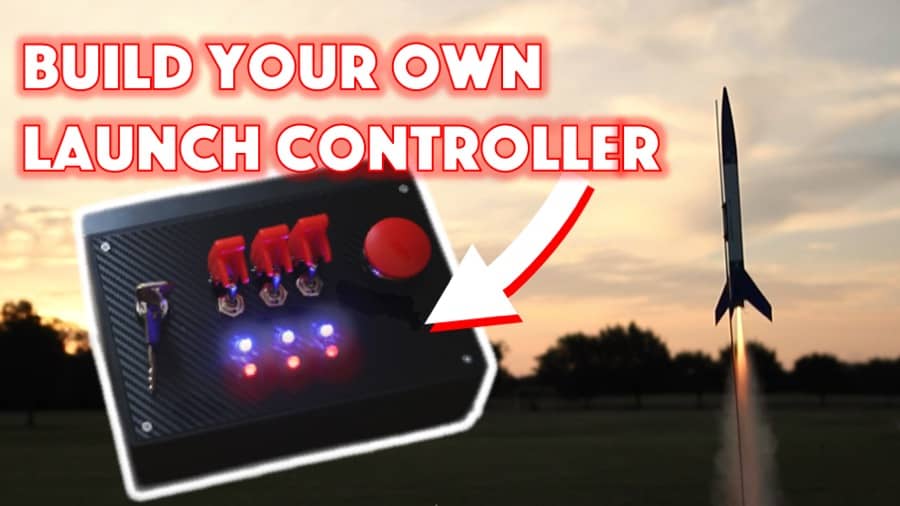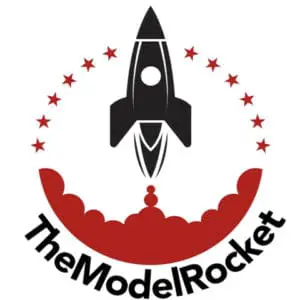
While watching some impressive high power model rocket launches on YouTube recently, I found myself in awe of the power of these rocket’s engines and the size of the rockets.
It got me to wondering, what is the largest model rocket engine? The most powerful and largest rocket engine used by amateur model rocket enthusiasts has an impulse class of S which can weigh over 400 pounds. The smallest rocket engines start at an impulse of A and every increasing letter is twice the engine size as the better before it.
Although the largest motor used by amateur model rocket enthusiast is extremely powerful, you won’t be getting your hands on one any time. Motors as powerful as the S have to be custom made, and they are highly regulated.
Are you still using the standard Estes controllers for your launches?
We just built our own beautiful launch controllers that make launches SO much more fun, and we documented EVERY single step and item purchased and put it into a step-by-step course that teaches you how to do the exact same thing.
Click here to learn more about how you can build your own launch controllers!

Impulse Class S Engine
It is hard to even imagine the amount of power an impulse class S model rocket engine has. Impulse classes for engines traditionally start with A and each class represents a range of total impulse.
Total impulse is measured by Newton seconds, which is the force of one Newton applied over one second. In beginner rocketry you don’t really need to understand or memorize any sort of scale for Newton seconds, but for the purposes of this article it’s interesting to see for context just how large the S sized engine is.
For A engines this range is between 1.26 and 2.50 Newton seconds. A typical class A engine is 18mm or .7 inches in diameter, 70 mm or 2.75 inches long, and the propellant weighs approximately 3.3 grams or .12 ounces.
As you make your way through the alphabet of impulse classes, each new level is doubling of the previous level. That means B engines have a total impulse between 2.51 and 5.00 Newton seconds. It comes in the same size as the class A engine, but the propellant is about twice as heavy.
Civilian Space eXploration Team
To give you an idea of just how powerful and large the S class engine is, let’s look at the S motor used by the Civilian Space eXploration Team (CSXT). In 2004, the CSXT made history by being the first amateur group to have a verified launch into space.
The propellant alone needed to launch the 21 foot rocket weighed 435 pounds and the case for the engine was 10 inches in diameter and over 14 feet long. The engine had over 655,000 Newton second’s worth of power. That is a big engine!
This massive and powerful engine carried the GO FAST rocket 72 miles into the air and reached Mach 5 speeds.
Regulations
As you can imagine there are some pretty tight restrictions on an engine that is capable of launching a model rocket into space. In order to launch a rocket using an S motor you need to get a permit from the Federal Aviation Administration by submitting an application to their Experimental Permit Program.
This is a long process where the FAA ensures that every detail of your proposed launch is reasonably safe and that the launch site you plan to use it large enough. The process generally starts a leave 150 days before a proposed launch.
Most of us won’t be launching a class S engine anytime soon.
Largest Motor You Can Use Without FAA Approval
Launching a 21 foot long model rocket into space with an S motor is all well and good, but you are probably still wondering what is the largest motor that you actually have a chance of using.
The largest model rocket engine available to purchase without getting approval from the FAA is an O. It is also the largest motor certified by the Canadian Rocketry Association, which has reciprocity with the TRA and the NRA. This means you might even be able to find this engine class for sale.
The largest and most powerful engine listed on the Combined CAR/NAR/TRA Certified Rocket Motors List is the Cesaroni O25000VM-P. This powerful engine is approximately 5 inches in diameter, 55 inches long, and weighs approximately 52 pounds with the propellant making up 32 pounds of the 52. You’re going to need a good sized sturdy rocket to use with it.
The crazy thing about this motor is that it releases that massive amount of power in 1.3 seconds.
Regulations for High Powered Engines
A high powered model rocket engine is any engine that has an average thrust greater than 80 Newtons regardless of impulse class. This is typically seen in engines with a classification of H or higher, but there are some F and G motors that have average thrusts that reach this level.
Websites that sell these rocket engines clearly list the requirements you must meet to purchase them.
In order to purchase a high powered engine, you must get a certification from the NAR or TRA.
There are three levels of certification:
Level 1 Certification: For the purchase of certain F and G engines as well as all H and I engines.
Level 2 Certification: For the purchase of J, K, and L engines.
Level 3 Certification: For the purchase of M, N, and O engines.
Level 1
To get the Level 1 Certification through the NAR, you must submit an application and fly a model rocket that you built yourself using an H or I engine at an NAR event. Before launching the rocket must pass a safety inspection, and you must answer questions related to safety.
The launch must be witnessed by the certification team members at the event and will be judged both during flight and after recovery.
Overall, the Level 1 certification is not all that difficult to obtain.
Level 2
To get the Level 2 Certification, you must take a High Powered Rocket Level 2 Written Exam and pass it with an 88% or better. You must do this before you can try the flight attempt.
For the flight attempt, you must first complete an application for Level 2 certification and then make your own model rocket and fly it using a J, K or L engine.
Just like with the Level 1 Certification, the model rocket will have to undergo a safety inspection and you will be expected to answer questions related to safety. The flight will be assessed by the certification team during flight and after recovery.
The test for the Level 2 Certification adds an extra level of difficulty.
Level 3
The Level 3 Certification is even more involved. You must first submit an application and a proposal of your plan for your model rocket.
You must document with photos parts of the rocket’s features that are hidden after the rocket is built, and there is a ton of documentation you will need to submit to the NAR at various points in the process and many safety measures that must be followed. The NAR wants to be sure that your advanced high power rocket is safe.
Launch day is very similar to the Level 2 and Level 1 Certifications. The rocket will be assessed during flight and after it has been recovered. If you are successful, you will be certified to buy and fly model rocket engines with an impulse classification of M, N, and O.
As you can see, the certification process is not just some arbitrary hoops that must be jumped through in order to purchase high powered motors. They are meant to ensure the safety of the flyer and to help them learn to build and fly high powered rockets.
Largest Motor You Can Use Without Certification
High powered model rocketry is not for someone with a passing interest in model rocketry. It requires real dedication to make it through some of the tests you must pass to get certification.
And, as much as it might pain you to have to make it through all three levels of certification before you can launch your dream rocket, this is a good thing. The regulations keep you and those watching you launch safe by ensuring that you have enough knowledge and experience to launch high powered rockets.
That being said, you can still get a lot of power out of the motors you can purchase without getting a certification. The largest model rocket engine that you can purchase without getting a certification is the impulse class G as long as the average thrust is not over 80 Newton seconds.
Class G engines have a total impulse of 80.01–160 Newton seconds. The Aerotech G80T-13 is one of the most powerful model rocket engines that you can purchase without a certification.
It is a 29 mm single use composite engine with a total impulse of 136.6 Newton seconds. It weighs approximately 4.6 ounces while the propellant weighs approximately 2.2 ounces.
Even though it is not considered a high power model rocket engine, it could launch a rocket like the Apogee Aspire, which is built for altitude, well over 4,000 feet into the air.
When Engine Size Doesn’t Matter
In general, a larger and heavier motor will be more powerful because there will be more fuel inside of it, but this is not always true.
There are two different types of model rocket engines commonly used to launch model rockets of all kinds.
The model rocket engine most people are familiar with is the black powder engines, which were the first model rocket engines sold widely. Since the 1980s another model rocket engine has been gaining in popularity, especially for high power model rocketry, and that is the composite engine.
One of the most important differences between these two types of engines is that the fuel in composite engines offers more power in smaller packages than the fuel in black powder engines. The total impulses of these engines will reflect this power difference, but the dimensions and weight of the engine will not be reflective of their comparative power levels.
In short, a smaller composite engine may actually be more powerful than a larger black powder engine.
The Takeaway
The largest model rocket motor available for amateur model rockery is a Class S motor, but this is out of reach for most of us. Most casual model rocket enthusiasts are not likely to ever use an engine larger than a G.
Of course, if you really want to launch with an extremely powerful engine, there’s no reason not to pursue it. Just take the certification process one step at a time, have fun along the way, and before you know it, you’ll be the one blasting rockets thousands of feet into the air at high speeds.
The sky’s the limit, after all.
Build Your Own Launch Controller
Don’t forget! You can ditch the stock controllers and confidently build your own from scratch using our step-by-step instructions and exact materials list! We promise this will make your launch experience 10x better, and using our course License to Launch you can be 100% confident you’ll be able to finish this project and be super proud of what you’ve built! Here’s a sneak peek below.
